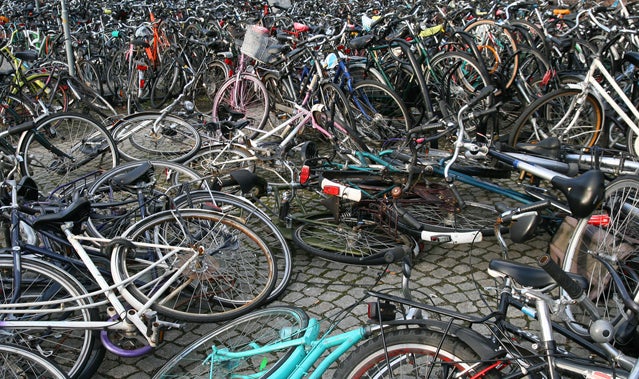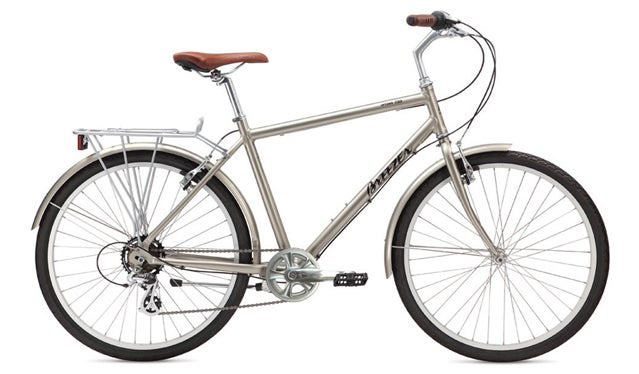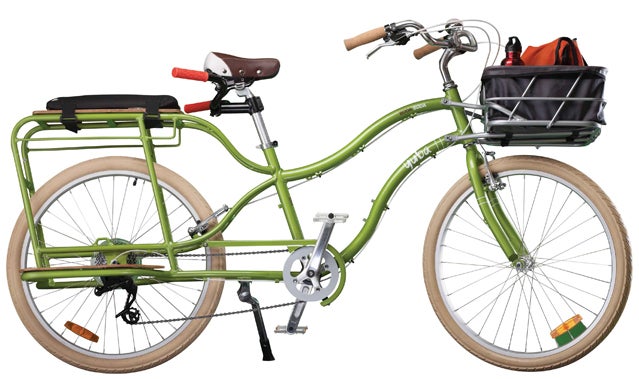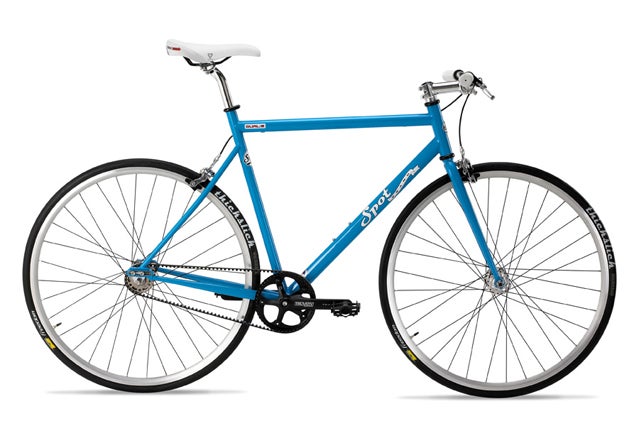Let’s start by stating the obvious: we take bike testing seriously at ���ϳԹ���. We review bikes year-round, riding some 100 bikes annually and logging hundreds of miles on each bike that gets reviewed in the magazine. Our testing culminates in a seven-day trip in January that includes dozens of riders and stacks of bikes.
This year, after publishing the results of all that testing in the May issue’s and the Summer 2012 Buyer’s Guide, requests poured in for reviews of less-expensive bikes. As some readers pointed out, we tend to focus on bikes that cost more. We do so because, in general, that’s where the bulk of development and innovation takes place. Also, bike prices have soared in recent years, meaning the dollar doesn’t go as far it used. But all your appeals got us wondering: What does a limited budget buy? And how cheap is too cheap?
Looking for answers, we sifted through dozens of lower-priced bikes out there to find the best values. Then we spent the past few months putting them to the test on Santa Fe’s streets. And while it’s still true that you get what you pay for, we were pleasantly surprised by some of the great values we found. Here, we present a series of reviews of utility bikes in the $500, $1,000, and $1,500 ranges.
The Best Budget Utility Bikes: Buying Advice
Shopping for a utility bike? Don’t think fancy, think function.

When we say utility bike, we’re talking about commuter or city bike built first and foremost for getting you around, whether that’s to work each day, to the market for groceries, or out to meet friends at your favorite watering hole. The good news is that because utility bikes are focused on function rather than high performance, there are a lot more inexpensive options. You pay less for utility bikes because the frames are made from sensible metals like aluminum or steel, the components are durable, hard-working mid-tier or lower grades, and the bells and whistles tend to be modest (like hub-powered lights and built-in locks).
But a bargain here doesn’t mean cheap: a good utility bike rides and handles as well as its trail or road counterparts and is burly enough to stand up to potholes, rain and road grime, and the scrum of bike racks. Since transportation is the end goal, don’t get too caught up on bike weight. Instead, consider geometry (upright for shorter distances; longer top tubes if you’re doing distance commutes), frame materials (steel is great for soaking up bumps, aluminum is lighter), wheel size (26-inchers make for more compact and maneuverable bikes; 700cc is a great option for longer rides), and tire size (fatter is smoother while skinnier is quicker).
Probably the biggest consideration is the bike’s drivetrain. First choice is single speed or gears, and while many utility bikes cut costs and complication by going one speed, it’s important to think about whether a single ring suits your environment (hilly places not so much) or your temperament (how do you feel about occasionally walking?). Next option is between standard gears and derailleurs or an internal hub. The former works fine, with trickle-down technology from performance bikes making even the least expensive systems adequate. Internally geared bikes, which pack the drivetrain inside the rear hub, offer simplicity, tidiness, and little maintenance, but they definitely cost more. Likewise, bikes that replace the chain with a Gates Carbon Belt Drive are great for commuting because they eliminate greasy pant legs and require zero upkeep. Again, however, the perks cost more.
Beyond the basic nuts and bolts, the trimmings require some scrutiny. Kickstands can be aggravatingly cheap and tipsy, so look for solid hardware and attachment points built directly into the frame rather than simple clamp-on designs. A chain-guard can keep your pants clean, but we recommend the half variety as the fully-enclosed designs are a total headache if you drop the chain. Fenders are de rigueur in wet climes, but if you live in, say, Phoenix or Santa Fe, they’re probably just ballast. And while Dynamo hubs that power built-in lights are great for recreational use or that occasional after-dark jaunt, if you’ll be commuting in the dark you might forgo the cost and put it toward more powerful lights.
As always, buy at a local bike shop for help with fit and after-sales service, and look for deals on last year’s models at the end of the bike season.
The Best $500 Utility Bike: Breezer Uptown EX

We’ve long been proponents of Breezer bikes because they pack tons of value into highly affordable packages. Case in point: , the least expensive bike in the Uptown line, whose fenders and rack are all but unheard of at this price point. And while the parts and specs are outstanding for the cost, the thing that really sets the Uptown EX apart is Breezer’s commitment to making an entry-level bike that rides as well as its more expensive models. Whereas other similarly-priced bikes pack crowd-pleasing bits like suspension forks to lure in buyers, the EX forgoes these (heavy and easily broken) whistles and bells and instead offers a simple, solid bike that will stand up to countless miles.
THE FRAME
This no-nonsense aluminum frame is built around 26-inch wheels for quick handling and better stand-over than 700cc models. We’re especially fond of the low-step LS model, which has as much clearance as you can get on a bicycle. The cockpit is somewhat short, so those with longer torsos may want to consider sizing up. As for positioning, it’s fairly neutral—more upright than the Dualie, but not nearly as erect as the Boda Boda.
THE PARTS
Here’s where this bike shines. Unlike cheap department store bikes that often come with easily-broken knockoff components, the Uptown EX is hung with a seven-speed Shimano drivetrain that surprised us with its quick, accurate shifting. The saddle, a house-branded design, shrugs off the tendency toward wide, pillowy seats and instead packs a mid-size, somewhat firm silhouette that was unexpectedly comfortable. And we loved the fenders, not just because they are sturdy and well designed, but also because the color-matching to the frame is an extra usually reserved for more expensive bikes. And Breezer’s kickstand design is one of the least tippy out there. One complaint: We miss the half chain guard from last year’s EX model.
THE BOTTOM LINE
There’s little to dislike about the Uptown EX: It’s a simple, smooth, bomber ride at a very manageable price. For those with a bit more budgetary leeway, the next model up in the line, the , is also worth a look. It’s the same frame as the EX, but for $880, it packs an internal-hub eight-speed drivetrain, a color-matched half chain guard, upgraded fenders, an uncomplicated suspension seat post, Dynamo-hub powered lights, and a bell. Either way, few other bikes deliver more utility for the price.
The Best $1,000 Utility Bike: Yuba Boda Boda Cargo Cruiser

With a swoopy, whimsical frame and whitewash balloon tires, this bike seems perfectly suited to neighborhood pedaling and easygoing afternoons strolls. But the is more than your average beach cruiser, thanks to a hefty cargo rack system integrated into the frame. It’s a stylish ride for trips to the farmer’s market or pedaling over for an afternoon on the water (yes, it can carry a surfboard or SUP).
THE FRAME
Built from sturdy 6061 Aluminum, the Boda Boda is a pretty cool piece of engineering, with seat and chain stays that extend straight into the built-in rack system. We prefer the continuous lines of the Step-Over model, which has almost as much clearance as a standard mixte, but women who often ride in dresses will appreciate the Step-Through version. The geometry is decidedly upright, which a few of our testers said resulted in slightly wobbly handling. And all the extra metal in the frame for the rack system pushes the weight to a hefty 36 pounds, making the bike more stolid workhorse than chipper speedster. Those niggles aside, several testers said they’re considering getting Bodas of their own.
THE PARTS
In contrast to the stylish looks, the components are mostly a good hard-working mix, including the 8-speed SRAM X3 drivetrain which, thanks to a generous 38-tooth ring up front, got us up even the steepest hills with a full load of groceries. It’s been awhile since we’ve ridden V-brakes, and Yuba’s reminded us just how well this simple design can work. Cork grips, springy faux leather saddle, and bamboo rack decking are all nice touches that add style. However, we found the kickstand inadequate for a bike this size and recommend upgrading to the Boda Double Stand ($69). That raises one other quibble: Though we’re happy to pay a little extra for true accessories (cushion and seat tube-mounted bars for passengers, for instance), features like a sturdy kickstand, a spring to keep the front wheel from over-rotating, and bamboo decking for the feet should be standard at this price.
THE BOTTOM LINE
Like the bicycle taxis in Africa from which the Boda Boda gets its quirky name, this bike can haul a surprising load, including, we found, two full-size adults in a pinch. It’s the minivan of bicycles, though with more panache than that designation suggests. If you’ve ever dreamt of ditching your car once and for all for a two-wheeled lifestyle, the Boda Boda might just be the perfect replacement. And if you need even more capacity (think SUV instead of minivan), Yuba’s will lug as much payload as your legs can manage.
The Best $1,500 Utility Bike: Spot Dualie

With the ($1,200), Spot has built a bike that’s hip enough for the fixie crowd but practical enough to serve as an everyday commuter. The secret is the Sturmy Archer two-speed kick hub, which packs two gears into a package that looks like only one. Add a smooth CroMoly steel frame that eats up rough pavement, the latest CenterTrack design of the Gates Carbon Belt drive, and that happy-go-lucky Scooter Blue color, and you’ve got a recipe for one fun bike.
THE FRAME
Oohing and aahing over steel bicycles is popular to the point of becoming a cliché, and for good reason. Steel blends the smoothness of carbon and the snappiness of aluminum into a solid, buttery ride that costs a fraction of composites. Beyond the road feel, we like the Dualie because it’s heavy-duty enough to mix it up with the chunkiest utility bikes on the front end of a bus. The CroMo frame is long in the top tube, which makes it great for stretching out and ticking off the miles. But it’s still crisp enough to outsprint cars at lights, courtesy in part to the short chainstays, and the handling is pleasantly chipper.
THE PARTS
What sets the Dualie apart from almost every other bike on the market is the two-speed kick hub, which shifts between an easy and hard gear when you backpedal a quarter of a revolution. It’s a clever system that works flawlessly, keeps the internals sealed away from the elements within the rear hub, and maintains the bike’s simple, clean aesthetic by nixing bar-top shifters and cables. The kick hub perfectly complements the Gates Carbon Belt drive, which is equally quiet, straightforward, and tidy. And Spot’s proprietary sliding rear dropouts mean that not only is there no fuss with re-tensioning the belt should you need to remove the rear wheel, but you can also run the bike with gears if you ever get the urge.
THE BOTTOM LINE
The Dualie felt as comfy as a handcrafted pair of shoes the first time we settled into the saddle, and it just got cozier the more miles we logged. The thin tires and more aggressive geometry make it perfect for blasting through in-town errands or knocking out long commutes, and it can even stand in well enough for a group ride with the roadies, provided you’re good at spinning. Unlike many utility bikes, which are stolid cycles made for commuting, the Dualie is a lively ride that’s made for riding hard, fast, and without abandon.


